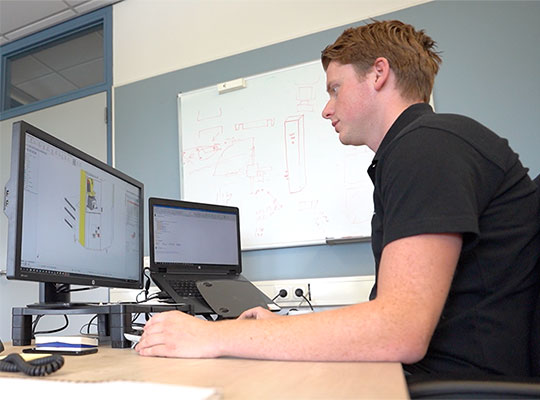Robot automation: Evolution, not revolution
The first thing Cellro tells new customers is that robot automation needn’t be an abrupt transition. The opportunities offered by Xcelerate are never implemented all at once; this is done step by step. Our Sales Engineer is happy to explore with you how Xcelerate could be incorporated into your production process. What tasks can the robot perform and how should it do so? And which tasks is Xcelerate not (yet) capable of performing? Xcelerate is always adapted to fit your production process, which often means that not all Xcelerate’s capabilities need be implemented immediately. Adding specific tasks to Xcelerate’s roster at a later stage is always an option.
Prerequisites for robot automation
To be able to implement robot automation, you must first meet various requirements:
- Your CNC machine is suitable and prepared for robot automation
- The programs are written in a CAD/CAM system
- Your employees believe that robot automation can support their production process
- The production of your product range is suitable for automation (e.g. a lot of diversity and small to medium-sized batches)
- Your company is open to applying new production technologies
If these prerequisites are met, it is still worth starting small when first implementing robot automation. That way you can familiarise yourself with the loading robot and get used to your new automated ways of working step by step. So, the evolution you’re initiating through the introduction of robot automation begins with your work process, not with the purchase of a robot for your CNC machine. Thanks to the modular design, you can always add different options later.
Room for your own ideas and innovations
Your machine operators will get to know the loading robot better every day and come up with more and more ideas on how to best use the robot. We see that customers using Xcelerate are very innovative in devising and applying solutions to suit their own product and process, and in determining how to involve the loading robot in this. And perhaps even more importantly, all the means to implement these innovations are available. Examples include robot grippers and fingers, drawers and inlays. When you decide to further optimise your production process, our Sales Engineer will work with you to determine what the next step should be.
Cellro tackles the situation with you
Cellro doesn’t just provide advice on which type of automation will suit you best, but also helps you consider which elements will need to be adapted or purchased as part of the solution. Robot automation then becomes more than the simple slotting of a robot into the current production processes. We believe it is worthwhile to return to the core issue and always ask: What is your goal in automating processes, how do you see it working for you and why do you want to automate these processes? Together with Cellro’s adviser, you can then determine how many of your products could be automated.
You will notice a major change in your approach to the process and planning. Where, previously, batches were planned and loaded separately, after implementing robot automation you will focus primarily on the processes and planning of multiple batches. How do you ensure that your CNC machine can continue working as long as possible, while finishing in time to supply the products for a subsequent process? Cellro is always willing to lend support on such issues. You can also start thinking about how to use the time of a program’s cycle to prepare new batches (which may continue throughout the night). Production planning is no longer led by the number of people available to load the machine at a specific moment. From now on, the planning focuses on the following question: When do I work on unique items, when on batches requiring extra care, and when do I turn on Xcelerate to load the more predictable batches?
How is the rest of your production process affected?
Companies in the metal industries frequently process raw materials and/or semi-finished products into products. This often happens at different stations and using different machines. If a process at one of these stations changes (for example, due to robot automation), causing orders to be processed faster or at different times, this will of course also impact the other machines. If those processes remain unchanged, the only thing that will happen is the ‘shockwave’ effect you may be familiar with from traffic jams. When a motorway is expanded, the next junction will receive more cars. If no further solution is provided, the problem is merely displaced. It is therefore essential to consider the changes that will result from this form of automation.
Want to find out more?
Are you looking for a robot for your CNC machine? Or would you like to learn more about robot automation? Please contact one of our experts.

